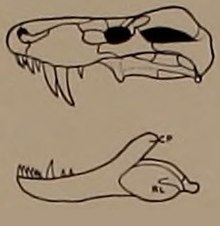Trochosaurus
| Trochosaurus Temporal range: Middle Permian,
| |
|---|---|

| |
| Reconstruction of a lycosuchid skull by Boonstra labelled as Trochosaurus | |
| Scientific classification | |
| Domain: | Eukaryota |
| Kingdom: | Animalia |
| Phylum: | Chordata |
| Clade: | Synapsida |
| Clade: | Therapsida |
| Clade: | †Therocephalia |
| Family: | †Lycosuchidae |
| Genus: | †Trochosaurus Haughton, 1915 (nomen dubium) |
| Type species | |
| †Trochosaurus intermedius Nomen dubium (=Lycosuchidae incertae sedis) Haughton, 1915
| |
| Other species | |
Trochosaurus (from Greek: τρόχoς trókhos, 'badger' and Greek: σαῦρος saûros, 'lizard') is a dubious genus of therocephalian therapsid from South Africa based upon specimens of Lycosuchidae. Three species of Trochosaurus have appeared in literature, T. intermedius, T. major, and T. dirus. The genus Trochosaurus and all three species are considered nomen dubia today, while the specimens referred to them are regarded as Lycosuchidae incertae sedis.[1][2]
Trochosaurus was named as a new genus of lycosuchid by Sidney H. Haughton with the species T. intermedius in 1915.[3] The same year, Robert Broom had named a second species of another, similar genus of large early therocephalian, Trochosuchus major.[4] In 1932, Broom concluded that the two taxa were synonymous and placed them in the new combination of Trochosaurus major, maintaining the generic separation from Trochosuchus while prioritising the older specific name. Broom described this separation as provisional, admitting it was uncertain whether Trochosaurus and Trochosuchus were actually the same or truly distinct.[2][5]
T. dirus was named by Broom in 1936 from a snout split into sections, although this holotype has since been lost and the species declared nomen dubium. Likewise, the holotypes of T. intermedius and T. major (as well as a referred specimen of the latter) are in poor condition and badly weathered, and lack any diagnostic features beyond Lycosuchidae. As such, Trochosaurus and its species are nomen dubia based upon undiagnostic lycosuchid incertae sedis.[1][2][6]
Like other lycosuchids, specimens attributed to Trochosaurus have only five large incisors in each premaxilla, two large functional canines in each maxilla, and few postcanines (four in T. intermedius). Haughton distinguished T. intermedius from existing lycosuchid genera at the time, Lycosuchus and Trochosuchus, by combining jaw proportions similar to Trochosuchus and similarly sized "double canines" as seen in Lycosuchus (unlike the smaller first canine reported for Trochosuchus).[3] However, due to the poor condition of the fossils attributed to Trochosaurus and the recognition that lycosuchid canines represent alternating replacements preserved in different stages of growth, these traits are no longer considered diagnostic beyond Lycosuchidae.[1][2]
References[edit]
- ^ a b c Abdala, F.; Kammerer, C. F.; Day, M. O.; Jirah, S.; Rubidge, B. S. (2014). "Adult morphology of the therocephalian Simorhinella baini from the middle Permian of South Africa and the taxonomy, paleobiogeography, and temporal distribution of the Lycosuchidae". Journal of Paleontology. 88 (6): 1139–1153. doi:10.1666/13-186. ISSN 0022-3360. S2CID 129323281.
- ^ a b c d Van den Heever, J. (1987). The comparative and functional cranial morphology of the early Therocephalia (Amniota: Therapsida) (Ph.D. thesis). University of Stellenbosch.
- ^ a b Haughton, S.H. (1915). "Investigations in South African Fossil Reptiles and Amphibia". Annals of the South African Museum. 12: 47–106.
- ^ Broom, Robert (1915). "Catalogue of types and figured specimens of fossil vertebrates in the American Museum of Natural History. Part 2 - Permian, Triassic and Jurassic reptiles of South Africa". Bulletin of the American Museum of Natural History. 25 (2) – via American Museum of Natural History.
- ^ Broom, R. (1932). The Mammal-like Reptiles of South Africa and the Origin of Mammals. London: H.F. & G. Witherby. p. 376.
- ^ Wyllie, Alistair (2003). "A review of Robert Broom's therapsid holotypes: have they survived the test of time" (PDF). Palaeontologia africana. 39: 1–19 – via CORE.





